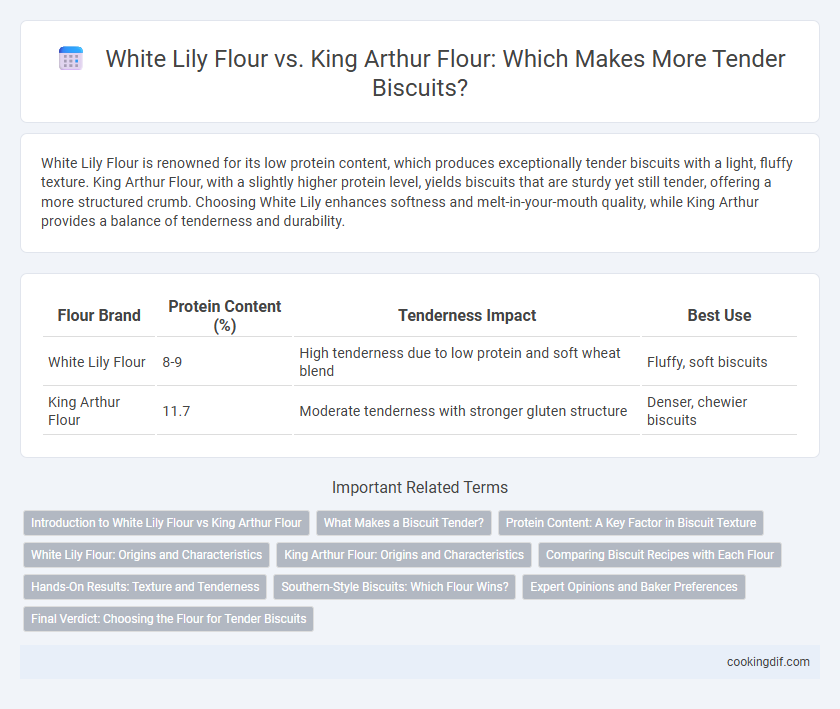White Lily Flour is renowned for its low protein content, which produces exceptionally tender biscuits with a light, fluffy texture. King Arthur Flour, with a slightly higher protein level, yields biscuits that are sturdy yet still tender, offering a more structured crumb. Choosing White Lily enhances softness and melt-in-your-mouth quality, while King Arthur provides a balance of tenderness and durability.
Table of Comparison
| Flour Brand | Protein Content (%) | Tenderness Impact | Best Use |
|---|---|---|---|
| White Lily Flour | 8-9 | High tenderness due to low protein and soft wheat blend | Fluffy, soft biscuits |
| King Arthur Flour | 11.7 | Moderate tenderness with stronger gluten structure | Denser, chewier biscuits |
Introduction to White Lily Flour vs King Arthur Flour
White Lily Flour is renowned for its finely milled, low-protein content which produces exceptionally tender and delicate baked goods, making it a favorite for biscuits. King Arthur Flour, with a higher protein percentage, provides more gluten development and structure, resulting in chewier textures but less tenderness compared to White Lily. Choosing between White Lily Flour and King Arthur Flour largely depends on the desired biscuit texture, with White Lily favored for soft, flaky results and King Arthur suited for more robust, hearty biscuits.
What Makes a Biscuit Tender?
White Lily Flour is preferred for biscuits due to its low protein content (8.5%), which produces less gluten and results in a tender, fluffy texture. King Arthur Flour contains a higher protein level (11.7%), leading to a denser, chewier biscuit because of increased gluten development. Tender biscuits rely on using soft wheat flour with low protein, minimal mixing to avoid overdeveloping gluten, and incorporating enough fat and liquid to create a delicate crumb.
Protein Content: A Key Factor in Biscuit Texture
White Lily Flour contains about 9% protein, which contributes to a more tender biscuit texture by limiting gluten development. King Arthur Flour has a higher protein content, around 11.7%, resulting in a slightly denser and chewier biscuit. Choosing White Lily Flour is ideal for achieving soft, flaky biscuits due to its lower protein content that produces minimal gluten formation.
White Lily Flour: Origins and Characteristics
White Lily Flour, originating from the Southern United States, is renowned for its low protein content, typically around 9%, which contributes to exceptionally tender biscuits. Its soft winter wheat base and fine milling process produce a flour that absorbs less liquid and creates a delicate, fluffy texture ideal for baking. In contrast, King Arthur Flour, with its higher protein content around 11.7%, offers more gluten development and chewiness, making White Lily the preferred choice for those seeking supreme biscuit tenderness.
King Arthur Flour: Origins and Characteristics
King Arthur Flour, established in 1790 in Vermont, is renowned for its consistent high-quality wheat, ideal for tender biscuits due to its balanced protein content around 11.7%. Unlike White Lily Flour, which is softer with lower protein (about 9%), King Arthur's moderate protein level contributes to a perfect texture--offering a tender yet slightly chewy biscuit structure. Bakers favor King Arthur Flour for its reliable milling standards and unbleached natural wheat, enhancing the biscuit's crumb and rise without sacrificing tenderness.
Comparing Biscuit Recipes with Each Flour
White Lily Flour yields exceptionally tender biscuits due to its lower protein content, which produces less gluten formation, enhancing softness and flakiness. King Arthur Flour, with a higher protein percentage, results in denser biscuits that offer more structure and chew. Recipes using White Lily typically require less liquid, resulting in lighter, melt-in-your-mouth biscuits, while King Arthur demands more precise hydration to balance tenderness and strength.
Hands-On Results: Texture and Tenderness
White Lily Flour delivers superior tenderness in biscuits due to its lower protein content, which minimizes gluten development and results in a softer, flakier texture. King Arthur Flour, with higher protein levels, produces denser biscuits that are chewier and less delicate. Hands-on testing consistently reveals White Lily's ability to create biscuits with a light, melt-in-your-mouth crumb compared to the more substantial structure from King Arthur Flour.
Southern-Style Biscuits: Which Flour Wins?
White Lily Flour is preferred for Southern-style biscuits due to its lower protein content (around 8.5%) compared to King Arthur Flour's higher protein content (11.7%), resulting in a softer, more tender crumb. The finely milled, bleached nature of White Lily ensures delicate gluten development, crucial for achieving the flaky layers characteristic of classic Southern biscuits. King Arthur Flour creates a chewier texture ideal for bread but can yield denser, less tender biscuits in this specific application.
Expert Opinions and Baker Preferences
Expert bakers often prefer White Lily Flour for its lower protein content, which contributes to exceptionally tender biscuits by reducing gluten development. King Arthur Flour, with a slightly higher protein level, provides more structure but may yield a less delicate crumb. Many seasoned bakers recommend White Lily for classic Southern-style biscuits due to its fine texture and consistent results in achieving optimal tenderness.
Final Verdict: Choosing the Flour for Tender Biscuits
White Lily Flour, made from soft red winter wheat and chlorinated for lower protein content, produces exceptionally tender biscuits with a delicate crumb. King Arthur Flour, higher in protein, results in a slightly denser texture but offers more structure and a heartier bite. For the ultimate tender biscuits, White Lily Flour remains the preferred choice among bakers seeking lightness and fluffiness.
White Lily Flour vs King Arthur Flour for tenderness Infographic

 cookingdif.com
cookingdif.com